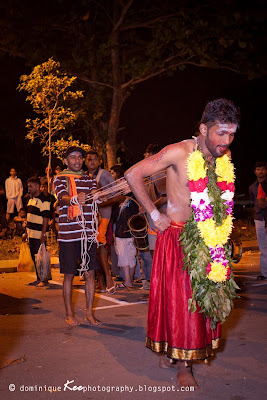Virtually all Malaysians know about Thaipusam every year. What more after it has (finally) been made a gazetted public holiday in Malaysia. Inevitably, we tend to associate this festival with kavadis, trances as well as and other forms of body mortification for spiritual purposes on this religious day. However, to truly experience this magnificent celebration, we ought to understand it a little better. Perhaps a little research can shed some light on this grand celebration which is often misunderstood outside the Tamil community.
For Thaipusam 2011, which falls on 20th January 2011, I will be heading down to Batu Caves, Gombak, Selangor at about 9.30 p.m. on 19th January 2011. From then, I shall attempt to witness and document the entire process - from the washing up at the river, to when the devotees enter into a trance-like state and to follow them all the way up to the temple cave embedded within the mountain. 272-step flight of stairs? Have camera, will travel!
For Thaipusam 2011, which falls on 20th January 2011, I will be heading down to Batu Caves, Gombak, Selangor at about 9.30 p.m. on 19th January 2011. From then, I shall attempt to witness and document the entire process - from the washing up at the river, to when the devotees enter into a trance-like state and to follow them all the way up to the temple cave embedded within the mountain. 272-step flight of stairs? Have camera, will travel!
Thai Pusam
Thaipusam (Tamil: தைப்பூசம்) is a Hindu festival celebrated mostly by the Tamil community on the full moon in the Tamil month of Thai (January/February). The festival is also referred to as Thaipooyam or Thaippooyam (Malayalam: തൈപ്പൂയം). The word Thaipusam is derived from the month name Thai and Pusam, which refers to a star that is at its highest point during the festival.
Legend has it that numerous battles were fought between the Asuras (bad guys) and the Devas (good guys) and for the most part, the Devas were getting their celestial behinds royally kicked around. Deperately seeking for a way to one-up these malevolent deities, the Devas then turned to the God Shiva for help. Shiva, in His benevolence created Murugan to aid the Devas in their victory over the Asuras. The Goddess Parvati then helps Murugan out by giving him the divine Vel (spear) so he could vanquish the evil demon Soorapadman and to finally achieve victory over the forces of the Asura. This festival marks and celebrates this successful campaign. This also explains the continuous chant of, "Vel Vel" which is heard throughout event - a reference to the divine spear.
I was pretty tempted to chant along with them, but I feared that it would offended some of the devotees, and I would be set upon by the vel, the prospect of which was highly undesirable.
I was pretty tempted to chant along with them, but I feared that it would offended some of the devotees, and I would be set upon by the vel, the prospect of which was highly undesirable.
Preparations
Devotees prepare for the celebration by cleansing themselves through prayer and fasting for approximately 48 days before the actual event. On the day of the festival, devotees will shave their heads and undertake a pilgrimage along a set route while engaging in various acts of devotion, notably carrying various types of kavadi (burdens). At its simplest this may entail carrying a pot of milk, but mortification of the flesh by piercing the skin, tongue or cheeks with vel skewers is also common. Generally, Hindus take a vow to offer a kavadi to a particular idol for the purpose of tiding over or averting a great calamity.
The simplest kavadi is a semicircular decorated canopy supported by a wooden rod that is carried on the shoulders, to the temple. In addition, some have a small spear through their tongue, or a spear through the cheeks. Other types of kavadi involve hooks stuck into the back and pulled by another walking behind.
While more modern practices exist, the general idea is to cleanse or purify oneself prior to participating in Thai Pusam.
Recent times have seen devotees getting more and more creative with their kavadi. While this whole process appears to be excruciatingly painful, devotees share that once they are in a trance, they feel no pain, there is minimal blood, and the horrific looking wounds heal as fast as they are made. Amazing, but true.
While more modern practices exist, the general idea is to cleanse or purify oneself prior to participating in Thai Pusam.
Recent times have seen devotees getting more and more creative with their kavadi. While this whole process appears to be excruciatingly painful, devotees share that once they are in a trance, they feel no pain, there is minimal blood, and the horrific looking wounds heal as fast as they are made. Amazing, but true.
For those of you who like statistics:
Vital Stats for January: 6 posts 694 pics
Vital Stats So Far: 45 posts 1,804 pics
Disclaimer: The contents of this photoblog is partly or wholly composed of amalgamated portions of information, para-phrased or otherwise, which is acquired from various public-domain websites. The Author’s rights are reserved only for the pictures and not the article itself. Thank you for reading.







































































Story told, emotions depicted, specific moments captured - I'd say its a pretty good 1st Thaipusam outing.
ReplyDelete